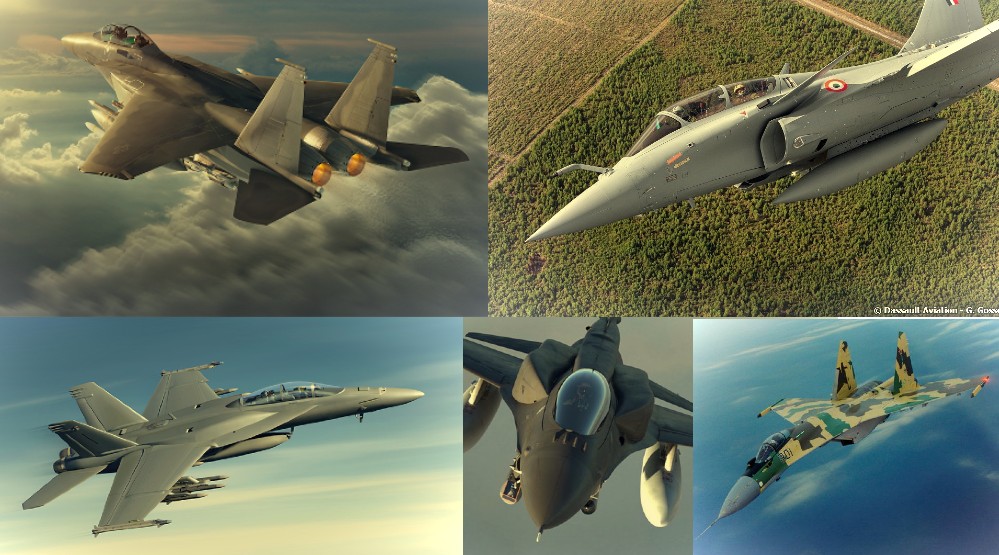
5 of 8 jets looking to compete for the 114 Made in India Fighter program
India’s quest to buy and locally build 114 new fighter aircraft will be “much more complicated” than the country’s notoriously doomed earlier effort for 126 fighters. In some straight talk from India’s only military airframer, the state-owned Hindustan Aeronautics Ltd (HAL), its chairman R. Madhavan has told Livefist that it is going to be very difficult (for the Indian Air Force) to formulate requirements that cater for deeply disparate aircraft types that have lined up to compete.
For a while now, India’s proposed program to choose a foreign fighter and build it in country through a Strategic Partnership, has reminded observers of the aborted Medium Multirole Combat Aircraft (M-MRCA) procurement program, which consumed years and millions, but didn’t result in a decision to buy and build 126 fighters. Instead, the collapsed deal spawned a separate effort that resulted in India settling for a much smaller quantity — 36 — of the winning aircraft, France’s Rafale.
The new program is following a similar path in many ways. Like with the M-MRCA, the new program seeks to buy a few jets off the shelf from the winning company, and then build over 100 of the rest in India at a new private sector facility. Like with the M-MRCA, the new effort is also seeing a line-up of deeply different jets, from heavy twin-engine fighters, to medium jets to light single-engine fighters.
Speaking to Livefist, HAL chairman R. Madhavan said, “The Indian Air Force will now have to make a RFI/RFQ (request for information/quotation) which meets both single and twin engine varieties. It will be very difficult to formulate an SQR (staff qualitative requirement) which covers both. So we have to wait and see how the IAF plays it, how they want their aircraft to be defined. Based on that, we will submit our quote.“
While the Made in India fighter program is intended to create aerospace capacity in India’s private sector, HAL already has potential skin in the game. In 2018, HAL unveiled a three-way partnership with Boeing and Mahindra Aerospace to support Boeing’s F/A-18 Super Hornet pitch in the contest. Since then, Boeing has decided to also make available the new F-15EX depending on how the Indian Air Force defines its requirements.
“Boeing now has both the F/A-18 as well as the F-15, which even the US Govt is buying. So Boeing has two offers in the 114 fighter jet program. Other than that, MiG-35, Su-35, Gripen, Rafale are also there. So it’s still a very open contest,” Madhavan said.
Asked specifically if the proposition reminded him of the doomed M-MRCA, Madhavan said, “It’s going to be much more complicated than the MMRCA. With the F-15 and Su-35, which are in a much higher weight category compared to the others. Their armament carrying capabilities change, maneouverability changes. It’s going to be difficult to cover both varieties with one SQR.”
Despite warning signs, the M-MRCA had seemed like a highly structured selection process that would defeat the obvious challenges of evaluating totally disparate fighter types. Former IAF chief Air Chief Marshal Pradeep Naik had even openly suggested patenting the M-MRCA evaluation process to license it to other countries looking to buy jets. In the end, the contest stalled, crashed and burned, was hauled over the coals by India’s national auditor, and resulted in India signing up for 36 of the winning jet, the Rafale, in 2016, over a decade after the M-MRCA program began.
The first IAF Rafale jets are expected to arrive in India next month, with deliveries to progress every few months.
Amidst border tensions with China, there has been heightened interest within the Indian establishment over speeding up critical procurements. And while there had been a quibble between India’s new Chief of Defence Staff (CDS) and the IAF chief over whether the 114 fighter program would go through amidst budgetary pressures and a stress on self-reliance, the HAL chairman was categorical in his view that the program, while delayed, would definitely go through.
“The Chief of Air Staff was categorical that we need these 114 fighters. It will not be junked, the only problem is timelines. In the present financial situation, it may not happen immediately,” Madhavan said.
Livefist has detailed the contours of bids by several of the contenders, including Boeing’s F/A-18 pitch, Saab’s Gripen pitch and Lockheed-Martin’s pitch of the F-16 variant that the company markets as the F-21 for the Indian contest.
Indian Defence Minister Rajnath Singh visited Moscow last week amidst a border escalation between India and China following an incident in the Galwan Valley that left several troops on both sides dead. In Moscow, he is understood to have obtained assurances on speedy delivery of India’s S-400 Triumf air defence systems by next year, and to clear decks for an anticipated order for 12 additional Su-30 MKI jets (which HAL will license build at its line in Nashik) and 21 MiG-29s built from old airframe shells, but brought up to upgraded standards. Livefist had detailed those programs here.
Watch Livefist’s full interview with HAL chairman R. Madhavan here, and do consider subscribing to Livefist’s YouTube channel here.
from Livefist https://ift.tt/3gasF0V
via Live Defense
 Reviewed by Unknown
on
04:46:00
Rating:
Reviewed by Unknown
on
04:46:00
Rating:

No comments: